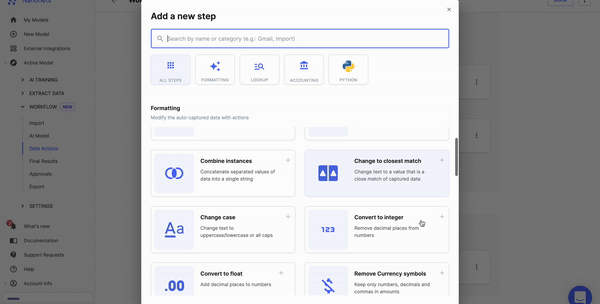
By 2025, organizations are expected to produce 175 zettabytes of business data. But only around 20% of that data will be employed to make business choices, according to a report by IDC. This indicates that most companies' information needs to be fully utilized.
Many firms are starting data merging projects as part of their digitization approach because of data redundancy. It is a method for linking those networks and producing a single source of truth.
The article discusses the significance of data merging and how it works. While we also discuss best data merging practices and use cases to give you a better idea of how data merging offers more precision to business data.
What is Data Merging?
Data merging is the process of integrating two or more comparable data into a unified database.
Data merging is used to add parameters to a database, append instances or observations, or remove repetitions and other inaccurate data.
When implemented correctly, data merging simplifies examining data stored across several sources, databases, or other sites. In some circumstances, combining data in a single database is essential. For instance, a company must add additional cases, parameters, or statistical information to the query values.
Data merging must be done since it can result in redundancy, reliability, or integrity difficulties. A data scientist will have to integrate new data into the primary or significant data file in one of two scenarios:
- They collected the information as part of a research, or "tracker." A program where a researcher gathers the data over time and examines it in periods.
- They possess data based on a meta-project, in which the researcher gathers data before and after an incident.
Why Should You Use Data Merging?
Data merging is a robust technique that can assist businesses in organizing and analyzing their material. We have mentioned a few benefits of data merging and why you should use data merging in your organizations.
Save Time & Resources
The method of merging information from several sources into a unified, cohesive piece of data is known as data merging. Even though it's time-consuming and tiresome, it's necessary to guarantee correct and current data. You may save money and time by automating the data merging process, and you'll be sure that the data is updated and accurate.
For example, Data merging can combine diverse customer, revenue, and inventory tracking datasets into a unified dataset. It would reduce the possibility of errors brought on by inaccurate data and make data analysis and corporate decision-making easier.
Improve Data Authenticity
You must ensure that your large datasets are precise and comprehensive when many sets are available. You can combine the data from each group into a single one by merging the sets.
That makes it possible to guarantee the accuracy and comprehensiveness of all the data. Additionally, it makes sure that the collection is free of redundancies. Integrating your databases has several advantages, and precision is one of them. All the data is guaranteed accurate when combined into a single set.
Convenient to Find Data
Each piece of data is combined within one place whenever the sets are merged. This guarantees that the data set is complete and free of gaps in knowledge. Since everything is in one location, it is simple to find and use.
Merging also makes working with and examining the set in its entirety simple. Everything is immediately in front of you, so there's no need to worry about searching through many files or attempting to piece together various portions of the data individually.
Analyzing Business Performance
When organizations merge data from many sources, they can obtain a more precise picture of what is happening within their company. This ensures that data sets can offer various viewpoints on the same subject.
Customer support data, for instance, can be employed to evaluate customer satisfaction. At the same time, businesses can use sales figures to gauge how an organization functions. Companies can fully comprehend their entire performance by merging data from many categories.
Streamlined Business Processes
Data can be combined for several purposes, including enhancing decision-making and optimizing company procedures. By combining data, organizations can get a more comprehensive and accurate view of what is occurring inside their company. This enables businesses to make more informed choices. Using information from the real world instead of depending on guesses or preconceptions.
Businesses can also use integrated data to spot patterns and trends that are only sometimes obvious—pointing out regions where they may need adjustments or enhancements. And also can assist businesses in enhancing their company's operations.
What are the Different Use Cases of Data Merging?
Following are the use cases of data merging employed across various industries.
Predictive Analysis
Using data, statistical, and machine learning approaches, predictive analytics determines the probability of future events based on records. Data merging plays a significant role in predictive analytics by giving a comprehensive and precise view of the data that may be utilized to create forecasts of future trends and patterns.
For Example, data merging is used to merge data from an enterprise's consumer behavior, sales, and inventories into a single dataset. Then, using predictive analytics approaches, this dataset may be examined to find patterns and trends that can be utilized to forecast future consumer habits, sales, and inventory requirements.
Customer Analytics
Customer analytics involves looking at consumer data to understand patterns, interests, and behavior. Data merging plays a crucial role in customer analytics by giving an accurate view of the customer information that can be applied to improve business decisions.
For instance, data merging is used to merge all the consumer demographic, transaction, and social network engagement data that an organization has into a single dataset. This database can then be examined to find patterns in consumer behavior, such as the most cherished products by consumers.
Financial Analytics
By merging data from several sources, financial analytics with data merging can give a more comprehensive view of a company's current financial status. companies can make better decisions by using this to spot patterns in financial performance.
For Example, data merging can be used to merge market data, analysis of projects, and economic transaction data that an organization owns into a single dataset. To detect trends in profitability, such as sales growth, cost patterns, and perceived risk, this database can be studied using financial analytics approaches, such as financial modeling and time series analysis.
Web Scraping
You can obtain data from your importation feeds that were not previously featured using web scraping. But might be accessible somewhere online, such as from your e-commerce business.
For instance, specific distribution methods and markets demand distinct GTINs (global trade numbers) for every item. Suppose they still need to be included in the merchandise feed. In that case, you can obtain the information you need by scraping internet databases. Or from your online marketplace, then integrate it with your feed.
Data Merging for enterprises.
Data merging plays a crucial role in how enterprises can use data effectively. Data merging allows businesses to get a complete view of their customers from start to end. This helps them make data-driven decisions. Here are some ways in which enterprises can use data merging:
- Data warehousing: Enterprises use data warehousing to store and manage large amounts of data. Businesses then use data from warehouses to support business intelligence and analytics.
- Master data management: Enterprises use data merging to create a "single version of the truth." By integrating data, they create a master data set that can be used for reporting and analysis.
- Customer data integration: Enterprises use data merging to create a unified view of customers. Multiple sources, such as CRM, marketing, and sales data, are used to understand customer behavior better.
- Supply chain management: Enterprises use data merging to combine data from different parts of the supply chain, such as inventory, logistics, and production data, to optimize operations and improve efficiency.
- Fraud detection: Enterprises use data merging to combine data from different sources, such as transaction data, customer data, and external data sources, to identify fraud patterns.
- Risk management: Enterprises use data merging to combine data from different sources, such as financial data, market data, and external data sources, to identify and manage risks.
- Human resources management: Enterprises use data merging to combine data from different sources, such as employee data, payroll data, and performance data, to manage and analyze workforce data.
Automate Data Merging with Nanonets
Nanonets is an AI-based document workflow automation platform. You can use Nanonets to automate various data processing tasks like data cleaning, collection, aggregation, storage, and more.
Nanonets connects with over 5000+ business applications, making collecting and exporting data in real-time easier. You can automate any manual process with Nanonets' no-code workflow.
Let's see how you can automate data merging on Nanonets from invoices to Xero.
You can set the entire data merging process on automation using simple no-code workflows.
On Nanonets, you can set up data merging easily:
Login or create a free account on Nanonets

Select the invoice OCR model from the main menu. In this case, we will extract data from invoices and then upload it to Xero.

Now, we can set up automated document collection.
Automatically collect the document using the document import options. Once this is done, your invoices will be automatically uploaded on Nanonets. And the invoice OCR model with extract data from the document.

Now comes rules. What do you want to do with the data?
You can set up rule-based no-code workflows to enhance data before merging the data. Like data formatting, capitalization, etc.

Once you've processed the data, you can share the data with your business applications using data export options on Nanonets. From here, you can select "Export to Xero" option and merge the extracted data easily.

It's very straightforward to set up data merging on Nanonets. You can start doing it yourself or reach out to our experts, who can help you set up workflows for your use case.
Read more about data processing on Nanonets:
Read more about data processing on Nanonets:
- How to improve data insights with data aggregation?
- Improve data consistency with efficient data matching
- Turn raw data into structured data with data enrichment
- Find the best data extraction tool in 2023
- Eliminate data inconsistencies with data wrangling
- Improve data quality with efficient data classification
- Best data migration tools in 2023



